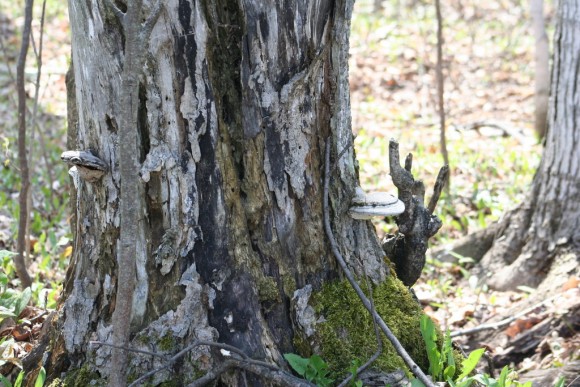Ashes to Ashes: Ash Wednesday Reflection by Avery Davis Lamb

Fungus on a Dead Tree Credit: Bev Currie
This Ash Wednesday, I’m not going to church. This Ash Wednesday I’ll be in my backyard communing with the Sweetgum, Loblolly Pine, and Crapemyrtle, the priests who know most intimately the cycle of ashes to ashes and dust to dust.
These trees know the smell of soil and ash intimately, as their lives are intertwined with both. A tree’s beginning is at the meeting point of seed and soil, when the conditions of moisture, light, nutrients, and innumerable other factors are ideal. The seed can smell the soil and know just when to crack out of its seed coat. Many species of tree, including the magnificent Giant Sequoia, require the regular presence of fire to sprout. When fire comes through the forest, the miniscule seed is released from its cone, able only then to enter its divine dance with the soil. From ashes and dust.
When is a tree pronounced dead? The question is a mystery to science. There is wisdom in the ambiguity, not knowing when it moves from being itself to being everything else. Because when a tree dies it does not cease to exist. It does not move from the realm of the living into the realm of the dead. When a tree dies, it makes space for the flourishing of more life all around and throughout its body. Through the fungus and microbes, wind and rain, fire and floods, the tree slowly returns to the dirt, offering itself back to everything. To ashes and dust.
These trees might teach us something about Ash Wednesday. Through their death into dust and ashes, they become life, dust and ashes for the flourishing of another. We learn from the trees that dust and ashes are not mere waste to be swept up and forgotten about, reminders that we come ex nihilo and go somewhere beyond this earth. Rather, like the trees, dust and ashes are the divine dirt through which God breathes the breath of being, and the divine dirt to which all beings return when we die.
What if the Ash Wednesday declaration “ashes to ashes and dust to dust” was seen not as an admonition that we come from and will return to nothing, but an invitation that we come from and will return to everything?
This Ash Wednesday, I’ll pass up the charred remains of last year’s leaves in exchange for the composted remains of last year’s leaves. I will go among the sanctuary of the trees, rub some muddy humus between my fingers, make the sign of the cross on my forehead, and mutter to myself “Remember that we are dirt, and to dirt we shall return.”
Avery Davis Lamb is a student, scholar, and activist, studying the intersection of Christianity and the environment at Duke Divinity School and the Nicholas School of the Environment.
Image credit: “Fungus on a Dead Tree,” May 13, 2008, Bev Currie CC, Flickr.


Start the Discussion